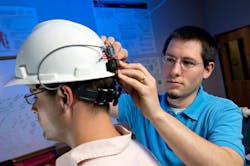Pulse oximetry helmet protects workers against carbon monoxide poisoning
Blacksburg, VA--An award-winning research paper entitled "Feasibility of Intelligent Monitoring of Construction Workers for Carbon Monoxide Poisoning" (see http://ieeexplore.ieee.org/xpl/articleDetails.jsp?reload=true&arnumber=6200386) from professors and engineers at Virginia Tech describes a wearable computing system installed in a helmet to protect construction workers from carbon monoxide poisoning. The danger exists because the exhaust from gasoline-powered hand tools can quickly build up in enclosed spaces and easily overcome the tool's users and nearby co-workers.
In the paper, the researchers explained how they integrated a pulse oximetry system into a typical construction helmet to allow continuous and noninvasive monitoring of workers' blood gas saturation levels. The results of their study showed that a user of this helmet would be warned of impending carbon monoxide poisoning with a probability of greater than 99%. The paper describes the system as a reflective pulse oximetry device, launching light from at least two light-emitting diodes (LEDs; typically one red and one infrared) and as many as 7 LEDs for more discriminating analysis onto the foreheads of the worker wearing the helmet and processing the reflected signal collected by a photodiode. As the heart beats, hemoglobin concentration values can be calculated by monitoring the blood volume level as a function of wavelength.
To show the feasibility of monitoring for carbon monoxide poisoning without subjecting the users to dangerous conditions, the researchers used a prototype for monitoring the blood oxygen saturation. The difference for monitoring for oxygen and for carbon monoxide differs only in the number of wavelengths of light used, so if this monitoring proved feasible, then the monitoring for carbon monoxide would be feasible as well. They selected a helmet for the installation of a wearable computer because they needed a design that could be worn year round which ruled out seasonal clothing such as overalls or coats. They also wanted a design that was socially acceptable, and one that struck a balance between comfort, usability, and feasibility.
"This helmet is only a first step toward our long-term vision of having a network of wearable and environmental sensors and intelligent personal protective gear on construction sites that will improve safety for workers," according to their report. "While this helmet targets carbon monoxide poisoning, we believe there are compelling opportunities for wearable computing in reducing injuries due to falls, electrocution, and particulate inhalation, as well as workers on foot being struck by vehicles."
SOURCE: Virginia Tech; https://vtx.vt.edu/articles/2013/08/081913-engineering-constructionhelmetsensor.html

Gail Overton | Senior Editor (2004-2020)
Gail has more than 30 years of engineering, marketing, product management, and editorial experience in the photonics and optical communications industry. Before joining the staff at Laser Focus World in 2004, she held many product management and product marketing roles in the fiber-optics industry, most notably at Hughes (El Segundo, CA), GTE Labs (Waltham, MA), Corning (Corning, NY), Photon Kinetics (Beaverton, OR), and Newport Corporation (Irvine, CA). During her marketing career, Gail published articles in WDM Solutions and Sensors magazine and traveled internationally to conduct product and sales training. Gail received her BS degree in physics, with an emphasis in optics, from San Diego State University in San Diego, CA in May 1986.
